Cheer Stunts: Complete Guide | Cheerleading Positions
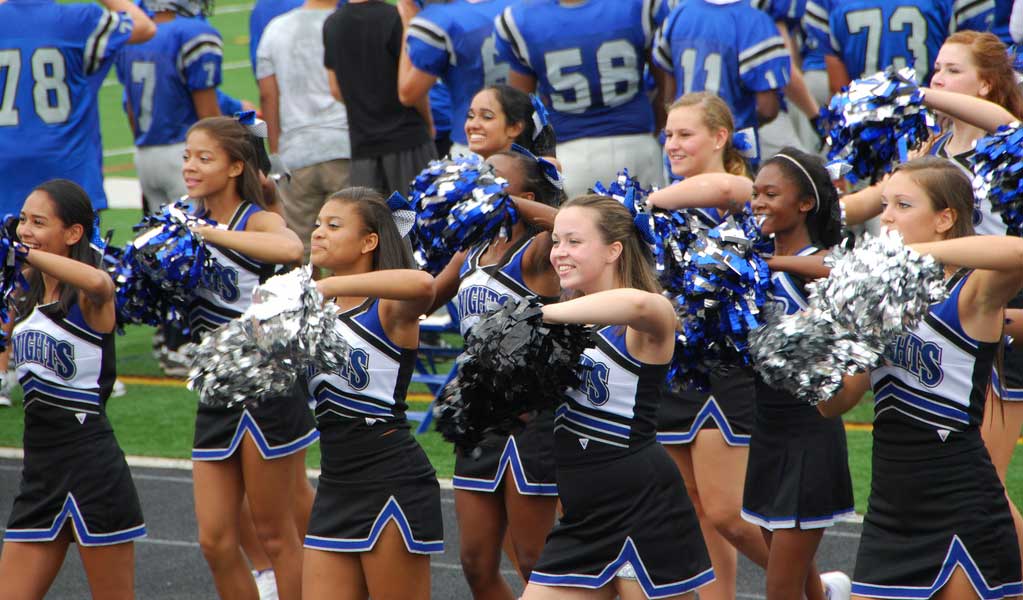
I believe that everybody is pretty much familiar with the word “Stunt” because we are all in touch to some extent by watching theater, television, or movies. It is a very common word and feature used in action movies. But I would still like to define and elaborate on this word, as the first step of my article is to draw a clear vision and then move on to my actual target, Cheer Stunts.
A stunt is an unusual, exciting, and dangerous act that requires a specially skilled person who can take risks and perform to rectify and gain publicity. Still, I have to do some touch bases and then jump to a real topic. Cheer Stunts have plenty of history and it’s a core component of Cheerleading.
Table of Contents
Cheer means to motivate and encourage someone by praising and shouting with joy. Cheerleading is an activity in which cheerleaders perform an organized athletic skill, dance, and chant to motivate and cheer their sports team and to amuse the audience.
The Beginning of Stunt Team
Basically, cheerleading performance is initiated to stimulate and build the team’s strength at the beginning of the game. It involves waving the pompoms on the sideline to attract the crowd. But, later on, when stunting became a part of chanting and cheering, it led cheerleading itself toward a competition.
It is found a new platform to show their talent and have recognition with unique innovations.
Cheerleading originated in the US at the school level. And the cheer stunting, a guy named Lawrence Herkimer played a vital role in making it popular.
He founded a cheerleading camp, where he works on creating and teaching new stunts and finally distributes them to all cheerleading teams. Trust and communication are the key factors of cheer stunt because every athlete relies upon and links to others.
Flyer
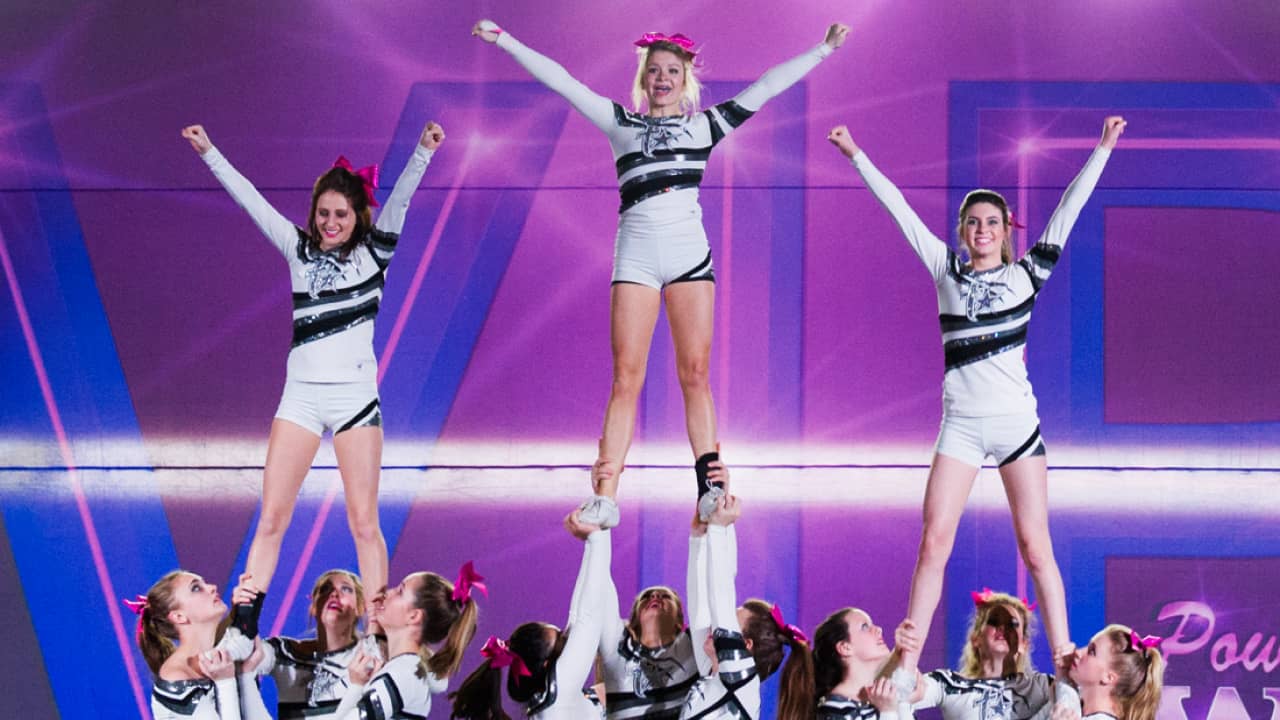
In a group stunt, you will usually see one flyer, two bases (one main and one side), along with a back spot or sometimes a front spot. Partner stunts will have two athletes, one flyer and one main base. They are usually coed, but all-girl versions exist. Based on the difficulty of the stunt performed and the rules and regulations governing that skill, a third athlete, known as a spotter, will be part of it.
The flyer is at the top of the stunt or pyramid. This is an advantageous attribute to hold, being a flyer, as many of the body positions require immense flexibility. The flyers are usually the shorter, slimmer people on your squad, but it depends on how capable other members of your team are and their requirements.
Bases
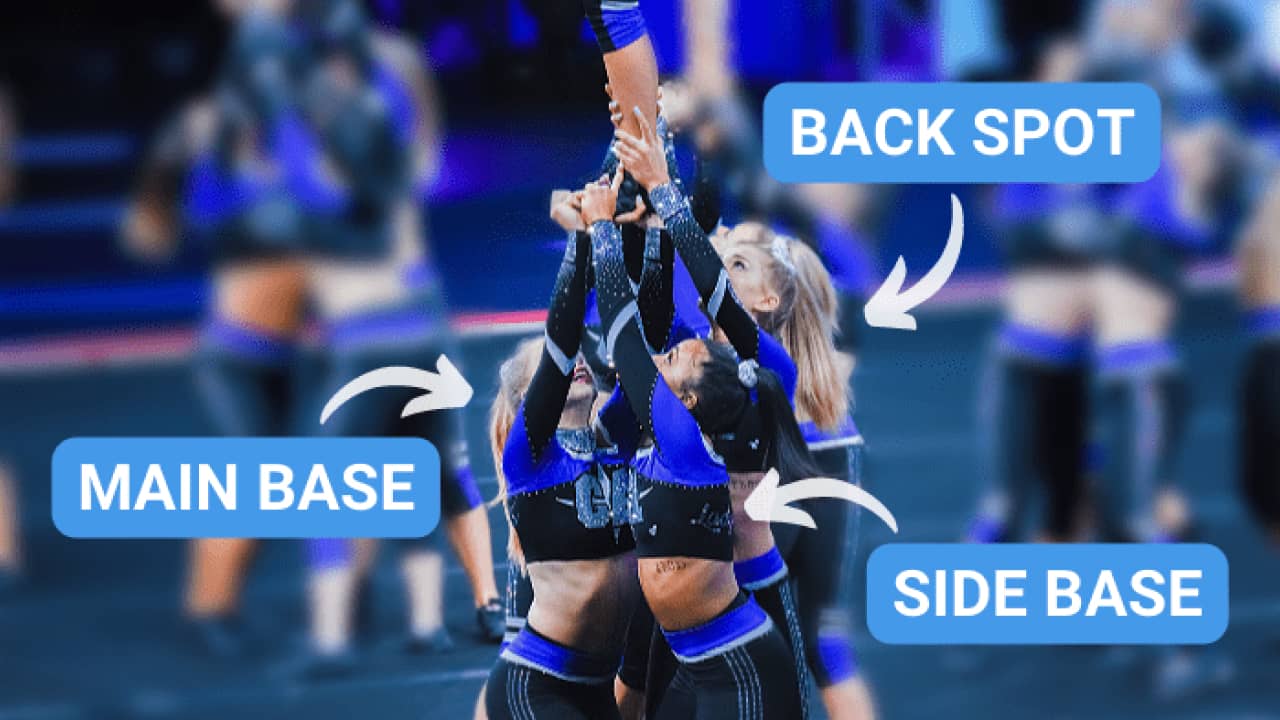
Bases are those cheerleaders who stand on the ground and hold the flyers and provide primary support to them. They are the responsible persons who are going to keep an eye on the flyers. They make sure the safety and also keep an eye contact with other bases to be on one page. Bases are not gender conscious means it can be either male or female. But they assure that the athlete who is going to stand in those positions is a strong cheerleader of the squad.
Main Base
Holds the majority of the flyer’s foot and stands straight under the flyer by bearing most of her weight. To stabilize, the main base will lift his/her heel and toe of the foot up from the ground from moving forward or backward in a leg extension stunt.
The main base is a powerhouse in a one-leg stunt because it carries 80% of the weight of the flyer. They hold the flyer foot from toe to heel by forming a cup shape hand under their foot. In order to provide a more stable platform to jump from.
Secondary Base
It is also identified as a side base and used in the one-legged stunt. In this, they hold the flyer’s foot from the middle /arch of the foot to throw and catch the flyer while main base gripping to spin the flyer.
Spotters

Spotters are a group of other athletes whose main job is to stand and watch the stunt, but if the flyer falls, they come in to help catch them. The primary function of the spotter is to prevent any injury to the head and neck of the flyer. Spotters involves in almost always maintaining the stunt, like a backside spot or at the back of a cheerleading stunt, if an incident were to occur.
Back Spot
It is the position where the cheerleader stands behind the cheer stunts to ensure the safety of the flyer. The back spot person attentively observes the Flyer’s shoulder and hip to watch the leaning position of the flyer. They work as a barrier between the flyer and the ground in case of any unwanted event. They boost up the flyer in a one-leg stunt, plus stabilize their ankles, and are also responsible for counting the stunt.
Front Spot
This is the position where the cheerleader stands in front of the stunt, facing back toward the audience to prevent the flyer from falling forward. A front spot is an optional support which cheerleaders normally use as extra help when they require. In order to lift the flyer for higher jumps, such as a basket toss. This position is usually assign to those people of the squad who are not flexible enough to be a flyer.
Additional Spot
This person is a safety precaution in the stunt. They just stand beside, in front or behind the stunt to observe the flyer and rush into the stunt in case of any mishap. This position in the stunt usually stays vacant. It occurs when they work on some new stunts, or cheerleaders are new to each other in the group.
Types of Cheer Stunts
There is a number of cheer stunts which cheerleader add to their routines for more excitement. Whether they are performing at the school level to cheer the team and audience, or in competition for scoring. To be a part of cheer stunts, one has to be physically healthy to carry out demanding acrobatic performances.
To be the best in cheer stunts, you have to be the best in basics means that you don’t really have to perform advanced stunts to impress the audience. A simple but well-performed one can capture the attention easily. Once you have a full command of beginner’s stunts, then later on, you can move to advanced and challenging stunts.
Athletes involved in cheerleading stunts work as a group, and the presence of each person is really important. If anyone is missing, then the stunt cannot be performed or practiced. Trust and communication are the key factors of cheer stunt because every athlete relies upon and links to others. It can be elaborated further by explaining the cheerleader’s positions.
Basic Two Leg Stunts
While these are just the basic types of stunting, they are the fundamentals of more advanced variations of stunts.
- Thigh Stand: Among the most basic of all stunts is a thigh stand. The bases can be seen kneeling on one knee, or in a lunge position with their front legs bent enough for the flyer to stand on their thighs.
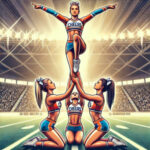
- Cupie or Awesome: The flyer is above the base’s heads. The flyer will have her feet together in a single base. If the guy’s free hand is on the hip, it is a cupie; if it’s is in a high V, then it is awesome.
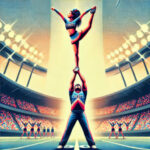
- Split-Lift or Teddy Sit: The flyer sits in a straddle, and the two bases are holding one hand on her thigh and the other on her ankle/foot. Her weight must be the focus of the flyer. This move is also known as the Straddle Sit.
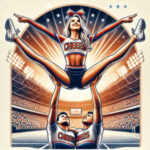
- Shoulder Stand: In a shoulder stand, the flyer is standing on their base shoulders.
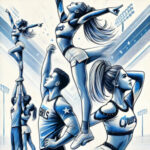
- Shoulder Sit: The flyer is on the base’s shoulders with her feet around its waist. It’s quite a stunt and an effective way to get your audience’s attention.

- Sponge: A loading position where the flyer is weight-bearing on straight arms on the base’s shoulders, and the bases are holding onto the flyer’s feet near their hips.

- Pony Sit: It is also famous as pony mount, and it can be the first stunt to start with. You need to get professional training. even for this one as it’s the base of your journey.
- Thigh Stand Variation: Once you get a perfect hold on the Double thigh stand, then u can play around and execute various variations.

- Hanging Stage: This stunt can be used by itself, or you can attach to a double thigh stand.
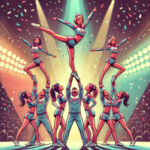
One Leg Stunts
- Liberty: Liberty or “Lib” is the most basic leg stunt. Two bases hold one of the flyer’s feet, with the main base almost always gripping the heel and toe, and the secondary (or side) base holding onto the middle of the foot. Stunt is performed at the chin (prep) level or extended.
- Tick-Tock: In this stunt, the flyer starts in a Liberty (one leg) and is softly releases to change legs to stand on the other leg. It can be done as a group stunt with two bases and a back spot or a partner stunt with just one base underneath. It will look like the flyer does an immediate switch of legs, floating from one foot to another.
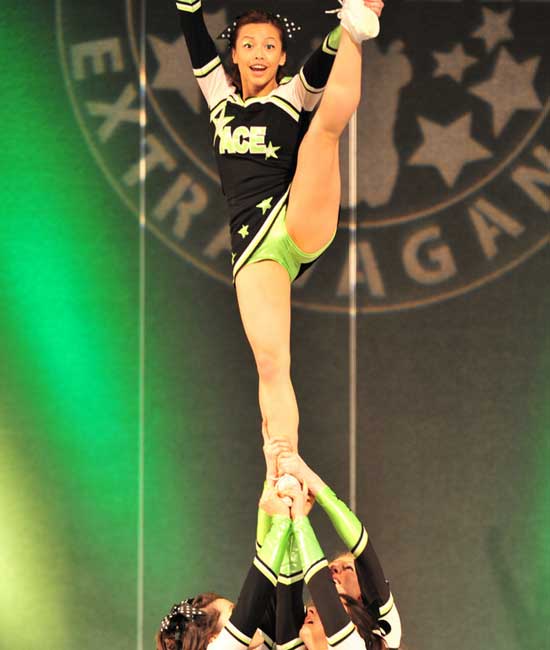
Basic and Advanced Cheerleading Stunts
The level of cheerleading motions toward the high jumps varies and have restriction to some extent by the schools. For example, the junior school’s cheerleaders do not perform difficult stunts due to the risk of injury, and the same goes for high school and so on. Anyway, the advanced cheer stunts are mainly extensions of the basics.
So, every cheerleader needs to be a master of their nuts and bolts if they are looking forward to their career as a cheerleader. The following are some of the easy stunts that beginners can perform, but they can be dangerous, so the presence of a supervisor is obligatory.

Synchronization and trust among the team members play an important role in performing an advanced, proficient stunt. It does take some time when the cheerleaders are new to each other, and of course the practice makes the man perfect.
I will mention the names of some stunts, such as toss to hands, chair, ground up full, liberty, scorpion, bow and arrow, Superman, basket toss, pyramids, kick basket toss, and many more. The cheerleader squads can come up with any practical idea, and then they all can work on it under supervision.
Body Positions
While a liberty, or “lib,” is the standard one-leg stunt, flyers will often execute body positions that demonstrate their flexibility. These are some of the tougher positions that help boost a team’s score in a competition. You can perform each of these body positions at prep (on the chin) or extension (above the head) level.
- Scorpion: The flyer captures their foot and curves their leg upward behind the body to touch the toes behind their head, much like a scorpion’s tail. The other hand securely holds the foot in place.
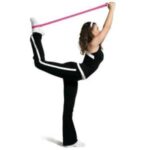
- Needle or Spike: This is an advance version of a scorpion with the leg perfectly straight behind her back.

- Scale: The hand grips the flyer’s outstretched leg alongside his/her body. This is like the Scorpion except one of the flyer arms holds her ankle or calf (not her toes), and the other arm is free.

- Heel stretch: Airborne, the flyer is pulling her foot as near to eye level as possible – either just from the heel or the middle of her foot – with that leg extended in front of her.
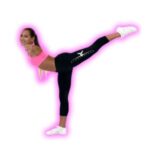
- Bow and Arrow: It’s a variation of the heel stretch. The flyer takes the opposite side hand from her foot and pulls her leg straight up next to her head. Then, she pulls the arm of her whole torso through the hole that was created when aligning a leg and arm, and holds it straight.
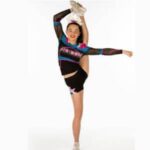
- Arabesque: The flyer flies out the leg behind them and attempts to externally rotate their hip socket so that when they are flying straight, the side of the leg is facing the witnesses.
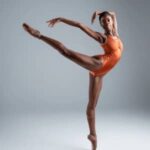
- No-hands/Chin Chin/Cry Baby: The flyer places her foot, holds it under her chin, and then balances that way hands-free.

Tosses
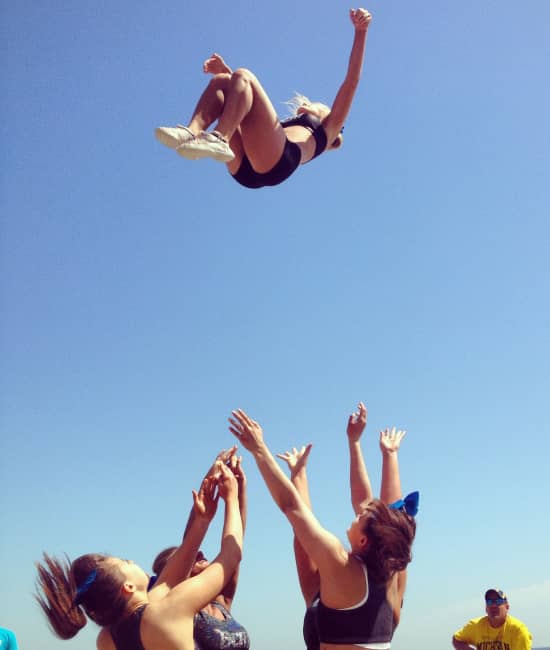
The basic basket toss is an easy skill, but it carries with it a lot of risk if not executed properly.
A basket toss earned its name from having bases interlock their hands to grip and launch a flyer into the air. The flyer comes from a load in position at the waist of the bases.
After being tossed, they may perform some skills or tricks before being caught in a cradle position.
These are some of the most typical skill performances during a basket toss. But there are many different variations and teams constantly developing new and creative basket skills.
Straight Ride Basket
The flyer releases from an overhead position. This pause allows her to lock out all the way overhead, with arms sounding close to your ears and body as straight as a pencil. After this, the flyer will end up in a cradled position.
The most fundamental stance for all basket tosses are typically in utilization by intermediate groups. Or as a warm-up stunt setting prior to undertaking the more complicated basket tosses.
Pike Basket
With the flyer at the top of the toss, she will tuck her knees into her chest to make her body a pike shape. On the way down, the flyer will then bend back (open) and land in a cradle position.
Toe Touch Basket
At the peak of the toss, this flyer will bring her legs up into a straddle or toe-touch behind you. During the descent, she may snap her legs back together and vary the arch back to further embellish the image.
Kick-Single/Double Full Basket
This is a basket toss skill on a more advanced level. As they reach the top of the toss, the flyer will kick her leg up and do an L-like motion with her arms. Then either rotate once or twice by wrapping her leg/arm across her body, which causes her to spin.
Back Tuck Basket
This is a flip basket toss, where the flyer is doing a hip-over-head rotation in the tuck position. This is usually a back tuck, but there exists a front flipping basket variation of this skill.
The X-Out Basket
This is a back tuck basket variation. Right at the ending split second of the back tuck, the flyer gets into an “X” position with their arms and legs open wide. Once they hit the “X” portion, the flyer rotates their body back towards a regular cradle position to be catchable by the bases.
Pyramids

However, pyramids are two or more stunt groups falling with the top people holding hands, feet, waist, or legs.
There are many types of pyramids, from waist-level skills by younger teams to multi-person high pyramids done by elite college squads.
Particularly, pyramid segments often involve all competitors on a team. It requires a considerable number of individuals to lift, spot, and catch a pyramid. Pyramid sequences are usually quick, and can include different levels, mounts, transitions, release moves, and dismounts.
Two High Pyramids
This is the basic pyramid and is mostly performs in cheer stunts. Flyers are supported by a base or bases standing on the surface where the stunts are performed. The flyers might link up in various ways, from handholding to one person grasping another’s outstretched foot or leg. One flyer can also use another flyer as a bracer while she executes a flipping or twisting release skill.
Two and a Half High Pyramid
This is a third layer of the pyramid, backed by anyone under the ground level. The middle level of flyers is kept level with the bases – typically in a shoulder-level stunt, just like in a two-guy tall standard pyramid. These guys will then have other flyers (usually around waist level).
Due to the height of this pyramid, these types are normally only performs by advance college or club squads, as the injury potential is extremely high. Other names and variations of the two and a half high pyramids are also useful. Such as the Swedish Fall, and the Wolf Wall (which has an added component called L Stand).
Guideline/Rules and Safety
As we all know that when cheerleading originated, it was not introduced as a sport, so there was no certain set of rules and regulations. But now, cheerleading has become a sport that demands more strength and gymnastic skills with the risk of injuries.
Such guidelines are a must to follow while making cheerleading movies as well, because only a trained athlete shall do such advanced moves. The USA Cheer has designed a safety program which includes some general guidelines for cheer stunts, such as;
- Trained by a qualified coach or advisor
- Practice should be supervised and carried out in a safe environment.
- Each team member should have access to check the capability of individuals to plan the stunts according to their level.
- Jewelry should not be allowed.
- Professional training in spotting should be compulsory
- Warm up routine should be carried out by the supervisor before and after the game
- Right surfaces should be used for pyramids, tumbling, partner stunts, and jumps
- Evaluation of individuals should be in practice quite often to keep track of whether they have mastery in respective skills.
Cheerleading Injuries
Cheerleading was initiated in 1898, and since then, it has started earning popularity. Technical complexity involving gymnastic tumbling and complex high-flying stunts put these athletes at high risk for injuries.
Pediatricians lately report that cheerleading injuries are more severe as compare to other sports in high schools, such as football, basketball, volleyball, etc. The most common injuries are;
Sprain/Strain
The most frequent type of injury that occurs in cheer stunts is the ankle sprain. It usually takes place when the flyer is unable to balance herself and land on the outside of the foot and twist the ankle inside. Use rice treatment straight away to reduce the swelling.
You Might Like to Read: America’s Sweethearts – NFL Cheerleaders Salary
But if athletes feel severe pain and cannot walk on the twisted ankle, then they need to consult a doctor. Because it is common to have bone injuries rather than ligament especially in younger athletes, an X-ray might be a requirement.
Knee Injuries
It normally occurs when a cheerleader lands awkwardly from a jump, which might tear the ligament, and you will feel sudden pain. Knee injury must get proper care and treatment because it takes time to heal and can get worse. There are some other knee injuries that can happen too. Due to the overuse of the knee, such as patellar tendonitis very obvious in such kinds of jumping sports.
Wrist and Elbow Injuries
While performing tumbling moves, flyers support the whole weight of the body on the wrist and elbow. It can end up in an injury, and the same applies to the cheerleaders standing on the bases to support the flyers. In this situation, the ligament tear, wrist fracture can take place. But it happens mostly when falling on the outstretched hand.
Back Fracture
Falling from a height leads to a vertebral fracture, and the severity depends on what extent of damage that happens to the vertebrae. Usually, it causes spine instability, which requires an operation. After surgery, the cheerleader will not be able to continue her/his career in cheerleading.
Head Injury
If the cheerleader, while performing, accidentally falls and, during the fall, if its head hits the ground, an injury called a concussion can occur, disrupting normal brain function on a temporary or permanent basis.
Clothes

Cheer stunts are not an easy task; they require plenty of practice to learn and polish the stunt to get the best out of it on the day of competition. Most cheerleaders have a uniform with the school logo to represent their school for the day. But as I mentioned earlier that they need regular practice, so uniforms should not be worn on a daily basis, otherwise they will be ruined.
Related Pick: How Much Do Dallas Cowboy Cheerleaders Make?
During regular practice, it is advisable to have comfortable and breathable clothes. Such as microfiber pants and tops because they are very flexible, plus they wick away your sweat and keep you cool during the practice. Cheer stunts are the activity that requires maximum movement, so Soffe shorts were introduced because it has maximum stretchability.
Some routines and dances that include gymnastic techniques barefoot are preferable, but you can wear running shoes with an anti-slip sole. Once you join the cheerleading team, the coach will guide you in detail about their requirement. You must tie-up the hair nicely so it does not play a hurdle role while practicing or performing.
Mental Preparation and Team Bonding
The cheer stunts not just talk about the physical flexibilities and strengths, but they hold a great significance in confidence, strong team-bonding, and mental resilience. As each single stunt relies upon coordination and timing, athletes needs to trust each other.
For motivation and building strong communication, the things expected from a cheerleader are open communication, team-building exercises, and positive reinforcement. These things should remain during competitions and practice, too.
Post‑Performance Recovery and Care
To prevent long-term injuries, the cheerleaders have to maintain a focused approach towards proper recovery. This focus should be maintained after every performance, hosting high-energy stunts.
Light stretches, hydrating towards maintenance of muscle health, and addressing all sorts of soreness with heat or ice therapy, are all sources for the recovery. The routines followed consistently will help in maintaining peak performance while extending the career opportunities of a cheerleader.
Conclusion
To have crowd-pleasing and powerful performances, cheer stunts showcase their efforts. This can only be possible when they combine their athletic skills, teamwork, and artistry in the performances they are presenting. Discipline, dedication, and shared trust between teammates are reflected in every single move they make.
Cheerleaders can give their best performance when they are live, minimizing the risks. The cheer stunts stand out to be the most inspiring elements in cheerleading. When there is a competitive arena happening, you’ll find them there.